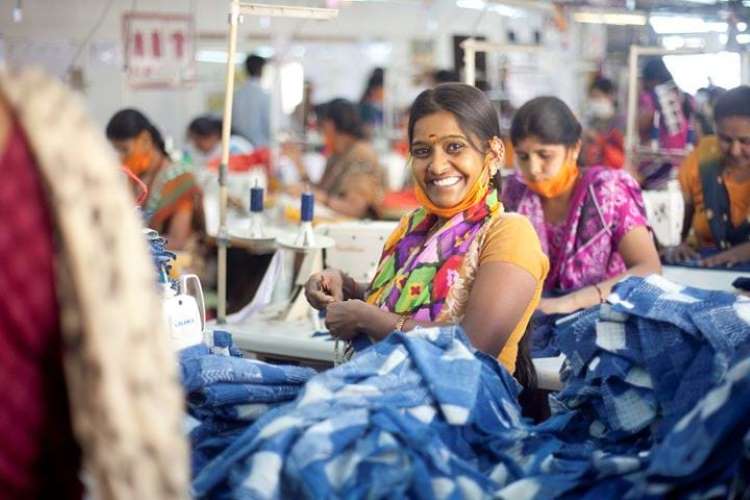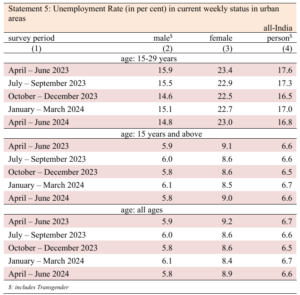
The Periodic Labour Force Survey (PLFS) for the April-June 2024 quarter offers valuable insights into India’s urban labour market. While the unemployment rate for those aged 15 years and above in urban areas has marginally dipped, there are underlying trends, particularly regarding female participation, that warrant closer examination.
The headline figure from the latest PLFS report is a marginal decrease in the urban unemployment rate, which now stands at 6.6%, down from 6.7% in the previous quarter. This slight improvement is reflective of the broader economic recovery post-pandemic, where the labour market has gradually stabilised after the disruption caused by COVID-19. However, this stability is not uniform across all demographics, with notable disparities between male and female workers.
READ I State-led growth key to unlocking India’s economic potential
Gender disparities in labour market
A major concern emerging from the data is the rising barriers for women in the urban labour market. The unemployment rate for women in urban areas rose to 9% in the April-June quarter, up from 8.5% in the previous quarter. This increase comes despite a slight reduction from the 9.1% recorded in the same quarter of the previous fiscal year. What is particularly troubling is that this rise in female unemployment occurred alongside a decrease in the female labour force participation rate (LFPR), which dropped to 25.2% from 25.6% in the preceding quarter.
This trend of rising unemployment and falling participation suggests that fewer women are seeking employment, yet those who do face greater challenges in securing jobs. The decline in the self-employment rate among women, from 41.3% to 40%, further exacerbates this issue. This decrease highlights the shrinking opportunities in the informal sector, which traditionally absorbs a significant portion of the female workforce.
Divergence in employment quality
The report also sheds light on employment quality, particularly among women. The decline in the share of women working as casual labourers, from 6.5% to 6%, points to a contraction in low-skilled, often precarious jobs that many women rely on. This contraction could be due to multiple factors, including automation, shifts in industry demands, and the ongoing challenges in sectors heavily affected by the pandemic. As the formal sector remains small, with limited capacity to absorb displaced workers from the informal sector, women are disproportionately affected by these structural shifts.

The overall LFPR in urban areas has seen a slight increase, rising to 50.1% from 48.8% in the same quarter last year. This growth is primarily driven by male participation, which increased to 74.7%, up from 74.4% in the previous quarter and 73.5% in the corresponding quarter last year. In contrast, while the female LFPR also increased from 23.2% last year to 25.2% this year, the concurrent rise in female unemployment rates casts a shadow over this progress.
The Worker Population Ratio (WPR), which indicates the proportion of the population that is actually employed, also reflects these gendered disparities. The WPR for males increased from 69.2% to 70.4%, while for females, it improved from 21.1% to 23.0%. However, the increase in female WPR is less significant when juxtaposed with the rising unemployment rate and declining LFPR, suggesting that while more women are entering the workforce, their chances of securing stable employment remain limited.
Structural challenges in female employment
One of the structural challenges is the decline in opportunities within the informal sector, which has historically been a significant source of employment for women. The latest unincorporated enterprises data, which reflects a contraction in this sector, aligns with the drop in self-employment and casual labour among women. This trend is particularly concerning as it points to a broader issue of declining informal sector opportunities, which could have long-term implications for women’s economic security.
One of the brighter spots in the report is the increase in the share of women in the formal sector, as indicated by the Employees Provident Fund Organisation (EPFO) data. The share of women among new EPFO subscribers rose to 27.3% in the first quarter of FY2025, up from 26.4% in the same quarter of the previous fiscal year. However, it is essential to contextualise this within the broader labour market. The formal sector represents a small fraction of India’s workforce, and gains here do not necessarily reflect broader trends in employment or labour force participation.
The EPFO data shows a slight increase in formal sector participation among women, which is encouraging. However, this must be viewed cautiously, as the formal sector still accounts for a minor segment of the overall labour market. The rise in formal sector employment is not sufficient to counterbalance the losses in the informal sector, where most women are employed. Thus, while more women are joining the EPFO, this does not reflect a significant shift in the overall employment landscape.
Addressing structural barriers
The April-June 2024 PLFS data highlights the need for targeted interventions to address the structural barriers that continue to impede women’s participation in the labour market. While the overall unemployment rate in urban areas has stabilised, the persistent challenges faced by women, particularly in the informal sector, highlight the need for policies that promote gender equality in employment opportunities. This includes enhancing access to formal employment, providing support for self-employment, and addressing the socio-economic factors that discourage women from participating in the labour force.
The government’s role in ensuring that economic recovery translates into equitable opportunities for all is critical. Policies must focus on creating an enabling environment for women, including improving access to skills training, expanding childcare support, and enforcing equal pay for equal work. Additionally, efforts to formalise the informal sector could provide more secure and sustainable employment opportunities for women, helping to bridge the gap between male and female participation rates.
As the Indian economy continues to recover, ensuring that this growth is inclusive, particularly for women, will be crucial in building a more resilient and equitable labour market. The insights from the PLFS should serve as a guide for policymakers to design interventions that not only sustain the overall positive trends but also rectify the persistent gender disparities that undermine the full potential of India’s workforce.
